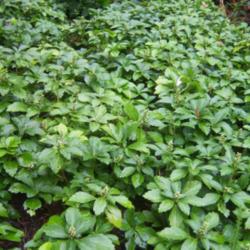| I have been trying for four years to grow a healthy stand of pachysandra in an area bordered by paving and sidewalks, serviced by an inground sprinkling system, that is also inhabited by a very old and very large ash tree. I believe that the ash tree roots are extracting all of the nutrients from the soil (which was very poor to begin with). I have never been able to achieve a strong stand. Many of the plants appear to have weak and stunted stems, especially near the top where the leaves appear. I noticed that the pachysandra near the tree's drip line is very yellow (on the order of lime green); the plants near the tree's trunk are still a (relatively) healthy green, though not vigorous. What organic fertilizer(s) would be appropriate to amend and enhance the soil and give the plants a chance to excel? What quantity and frequency would be needed. Which specific chemical would most likely be missing for this condition to exist? Nitrogen? |

Once established, pachysandra is very drought tolerant, so moisture isn't an issue. A topdressing with rich compost each spring is all the "feeding" the plant needs, as long as the pH is correct. When growth picks up in spring, you can shear the plants back or mow about 25% of the leaf surface to stimulate branching, and lush growth. |